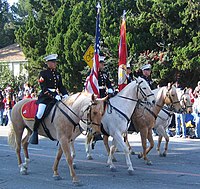Colour guard

In the military of the United States and other militaries, the color guard (where the word color is referring to the US flag) carries the National Color and other flags appropriate to its position in the chain of command. Typically these include a unit flag and a departmental flag (Army, Marines, Navy, Air Force, or Coast Guard). In addition to the flag bearers, who are positioned in the center of the color guard, there are two individuals who carry rifles.
History
Since early history, flags and banners have been used by many armies in battle. They served several purposes: to identify units, for signaling and to be a common point of reference for the movements of the soldiers in the unit, enabling them to keep formation. The flag was also a symbol of the unit. The loss of a unit's flag was not only shameful, but losing this central point of reference could make the unit break up. To protect the flag, a detachment of soldiers was assigned to guard it.
Composition


In the U.S., traditionally, the unit's sergeant major is responsible for the safeguarding, care, and display of the organizational colors. He is also responsible for the selection, training, and performance of the members.[1] The color guard consists of enlisted members and is commanded by the senior (color) Sergeant, who carries the National Color and gives the necessary commands for movements and rendering honors during drill exercises or parade ceremonies.[2]
Being assigned to the color guard is considered an honor due to the fact that these individuals present and carry the symbols of their unit and country. Depending on the circumstance and subject to the orders of their commander, members may wear full dress or less formal uniforms. It is mandatory for all members of the color guard to wear headgear, for example, a garrison cap, beret, or service cap. On occasion, certain color guards can be horse-mounted.
Maneuvering

The color guard is formed and marched in one rank at close interval (shoulder-to-shoulder). Since the National Colors must always be in the position of honor on the right,[3] the color guard must execute a special movement to reverse direction. It does not execute rear march, nor does it execute about face. Rather, it performs a maneuver derived from the standard countercolumn command, generally known as counter march or colors reverse march, in order to keep the precedence of flags in order.
Other drill movements performed by the color guard include presenting arms, left and right wheel (turns) marches, eyes right (upon passing the reviewing stand during a parade), casing/uncasing the colors, and fixing/unfixing bayonets (by the arms bearers).
Rendering honors

By the color guard
The color guard renders honors when the national anthem is played or sung, when passing in review during a parade, or in certain other circumstances. In these cases, the unit and departmental flags salute by dipping (leaning the flag forward). However, with the exception of a response to a naval salute, the United States national flag renders no salute. This tradition comes from the 1908 Summer Olympics in London, where countries were asked to dip their flag to King Edward VII: the American team captain Martin Sheridan refused in support of an Irish boycott over Great Britain's refusal to grant Irish independence, with a compatriot famously proclaiming that "this flag dips to no earthly king."[4]
To the color guard
In the U.S. military, individuals or units passing or being passed by uncased (unfurled) colors render honors when outdoors. Individuals who are not part of any formation begin the salute when the colors are six paces distant and hold it until they have passed six paces beyond the colors.[5]
Civilians are expected to stand at the position of attention with their right hand placed over their heart for the same period.
Veterans and servicemembers may perform a hand salute during the National Anthem thanks to new regulations.[6]
References
Notes
- ^ FM 22-5, Section 9, Paragraph 43 (e) (United States Department of the Army)
- ^ FM 22-5, Section 9, Paragraph 45 (a) (United States Department of the Army)
- ^ FM 22-5, Appendix E, Section 4 (United States Department of the Army)
- ^ London Olympics 1908 & 1948
- ^ FM 22-5, Section 9, Paragraph 43 (c) (United States Department of the Army)
- ^ http://www.af.mil/news/story.asp?id=123121980
External links
- Continental Color Guard of The Old Guard
- MCO P5060.20 US Marine Corps Drill and Ceremonies Manual Chapter 7
- U. S. Air Force Honor Guard
- U.S. Coast Guard Ceremonial Honor Guard
- U.S. Coast Guard Auxiliary 11th District Southern Region, Division 12, Flotilla 12-04 Color Guard
